Drax Company: Adapting LMOR for Innovation in Emerging Tech
VerifiedAdded on 2022/11/29
|13
|3278
|312
Report
AI Summary
This report critically analyzes the implications of Leadership, Management, and Organizational Resources (LMOR) in Drax Company's introduction of new products and services by adapting to emerging technologies like the Internet of Things and Artificial Intelligence. It examines the changing skills required, capabilities and knowledge management, operations management, human resource management, and leadership styles necessary for the company to innovate and regain its market position. The report discusses the importance of recruiting skilled professionals, managing existing knowledge effectively, creating efficient operations, implementing high-performance work systems, and adopting appropriate leadership styles to achieve the company's strategic aims in a competitive environment. It also highlights the opportunities and challenges associated with implementing advanced technologies and organizational changes, emphasizing the need for continuous training, development, and effective communication within the company.
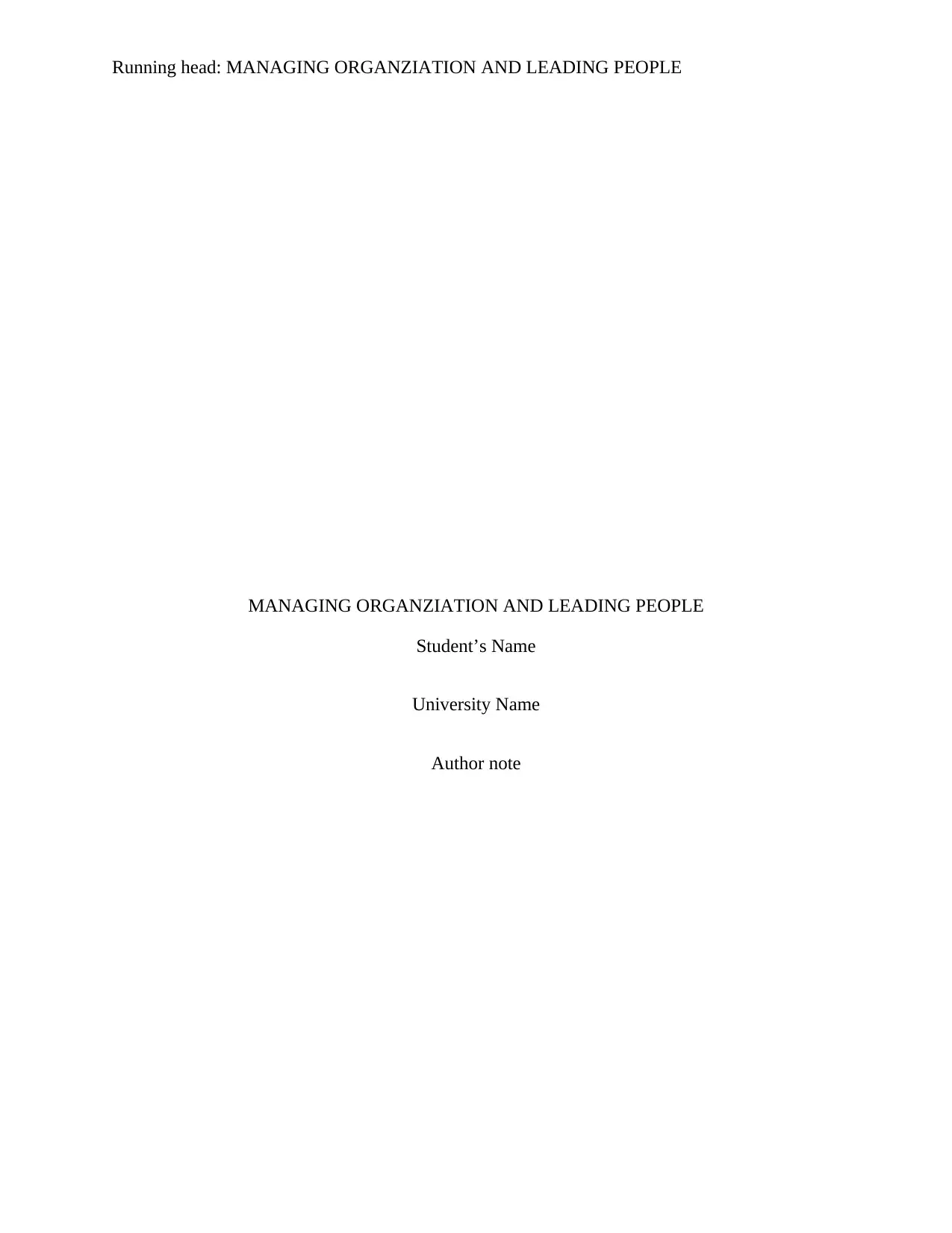
Running head: MANAGING ORGANZIATION AND LEADING PEOPLE
MANAGING ORGANZIATION AND LEADING PEOPLE
Student’s Name
University Name
Author note
MANAGING ORGANZIATION AND LEADING PEOPLE
Student’s Name
University Name
Author note
Paraphrase This Document
Need a fresh take? Get an instant paraphrase of this document with our AI Paraphraser
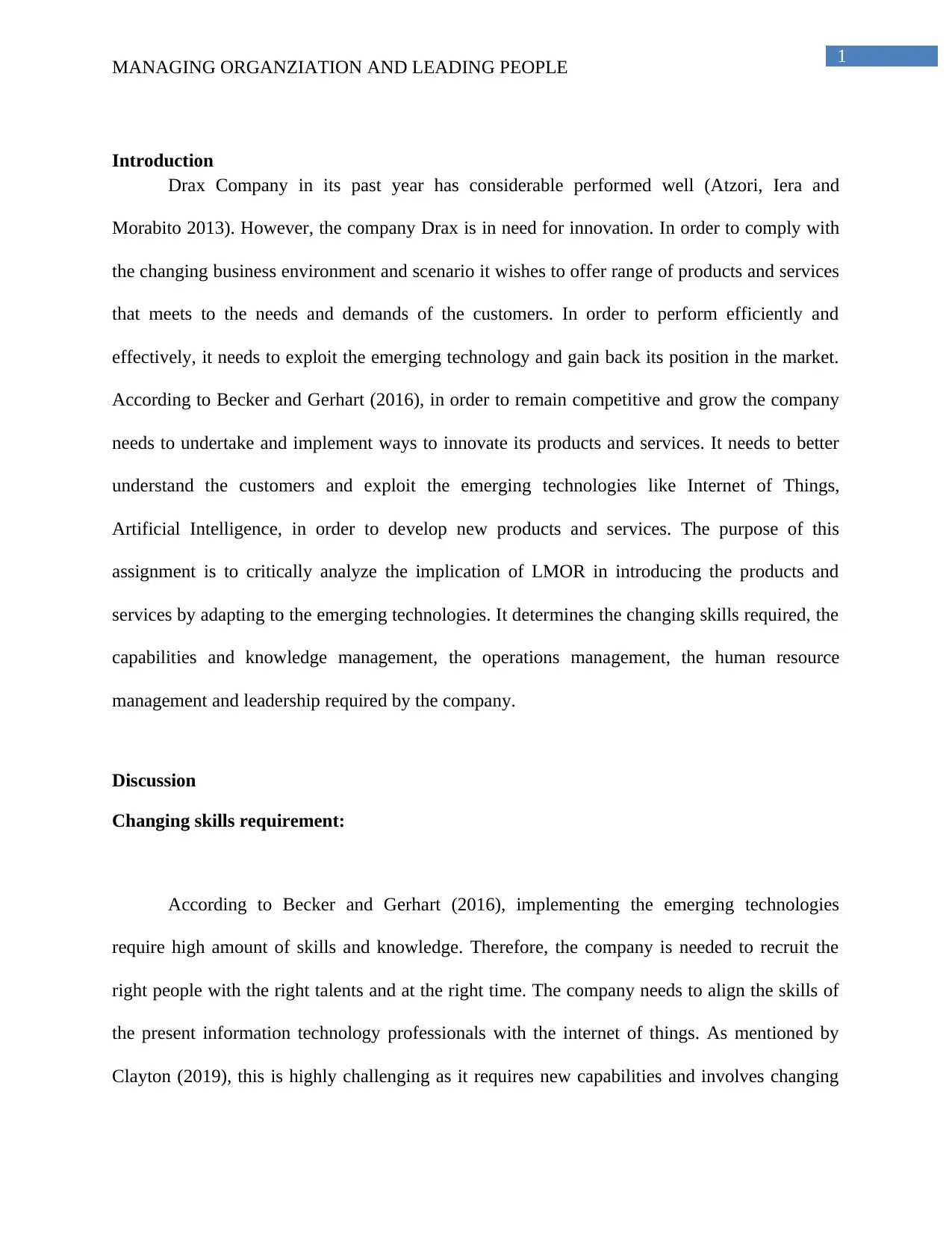
1
MANAGING ORGANZIATION AND LEADING PEOPLE
Introduction
Drax Company in its past year has considerable performed well (Atzori, Iera and
Morabito 2013). However, the company Drax is in need for innovation. In order to comply with
the changing business environment and scenario it wishes to offer range of products and services
that meets to the needs and demands of the customers. In order to perform efficiently and
effectively, it needs to exploit the emerging technology and gain back its position in the market.
According to Becker and Gerhart (2016), in order to remain competitive and grow the company
needs to undertake and implement ways to innovate its products and services. It needs to better
understand the customers and exploit the emerging technologies like Internet of Things,
Artificial Intelligence, in order to develop new products and services. The purpose of this
assignment is to critically analyze the implication of LMOR in introducing the products and
services by adapting to the emerging technologies. It determines the changing skills required, the
capabilities and knowledge management, the operations management, the human resource
management and leadership required by the company.
Discussion
Changing skills requirement:
According to Becker and Gerhart (2016), implementing the emerging technologies
require high amount of skills and knowledge. Therefore, the company is needed to recruit the
right people with the right talents and at the right time. The company needs to align the skills of
the present information technology professionals with the internet of things. As mentioned by
Clayton (2019), this is highly challenging as it requires new capabilities and involves changing
MANAGING ORGANZIATION AND LEADING PEOPLE
Introduction
Drax Company in its past year has considerable performed well (Atzori, Iera and
Morabito 2013). However, the company Drax is in need for innovation. In order to comply with
the changing business environment and scenario it wishes to offer range of products and services
that meets to the needs and demands of the customers. In order to perform efficiently and
effectively, it needs to exploit the emerging technology and gain back its position in the market.
According to Becker and Gerhart (2016), in order to remain competitive and grow the company
needs to undertake and implement ways to innovate its products and services. It needs to better
understand the customers and exploit the emerging technologies like Internet of Things,
Artificial Intelligence, in order to develop new products and services. The purpose of this
assignment is to critically analyze the implication of LMOR in introducing the products and
services by adapting to the emerging technologies. It determines the changing skills required, the
capabilities and knowledge management, the operations management, the human resource
management and leadership required by the company.
Discussion
Changing skills requirement:
According to Becker and Gerhart (2016), implementing the emerging technologies
require high amount of skills and knowledge. Therefore, the company is needed to recruit the
right people with the right talents and at the right time. The company needs to align the skills of
the present information technology professionals with the internet of things. As mentioned by
Clayton (2019), this is highly challenging as it requires new capabilities and involves changing
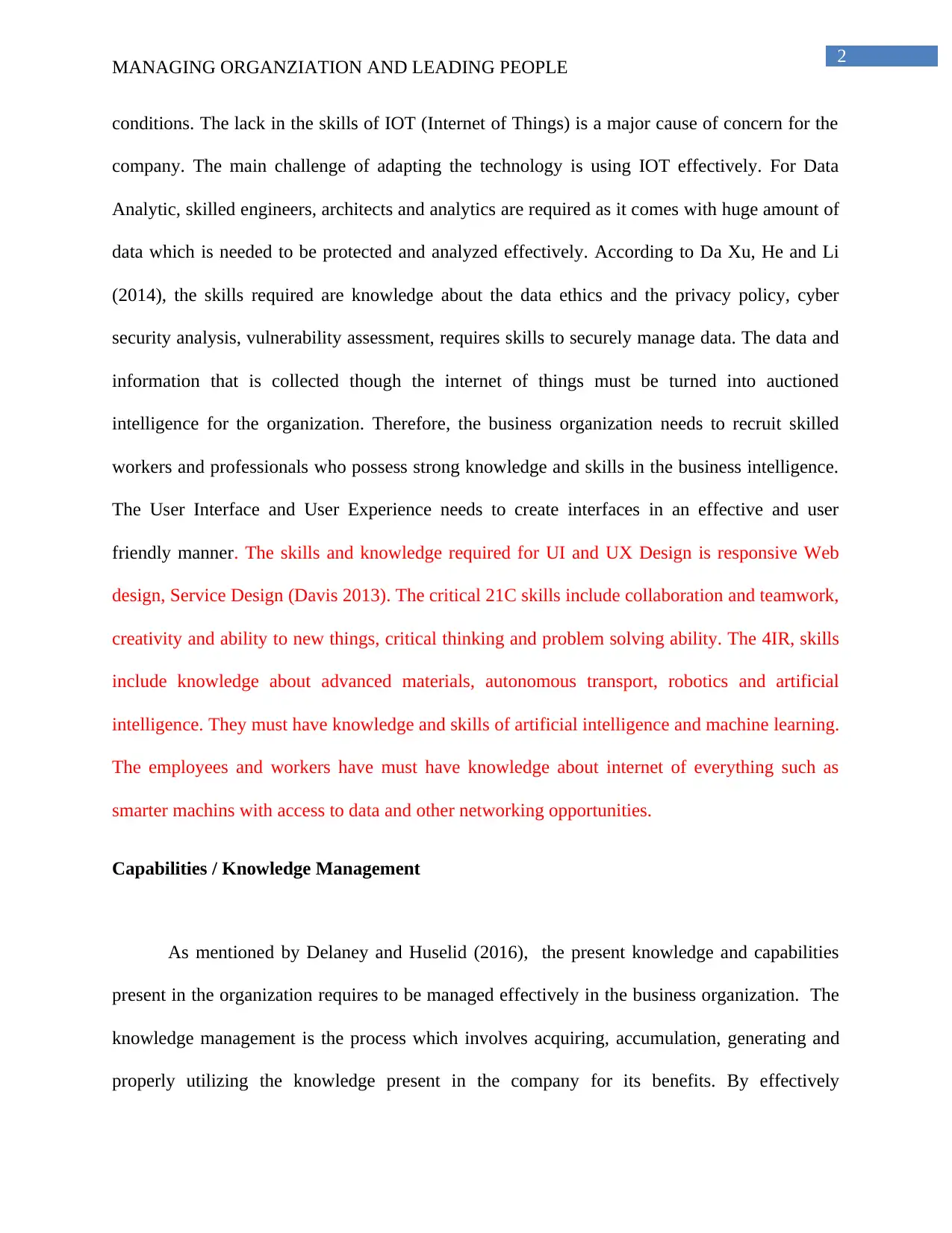
2
MANAGING ORGANZIATION AND LEADING PEOPLE
conditions. The lack in the skills of IOT (Internet of Things) is a major cause of concern for the
company. The main challenge of adapting the technology is using IOT effectively. For Data
Analytic, skilled engineers, architects and analytics are required as it comes with huge amount of
data which is needed to be protected and analyzed effectively. According to Da Xu, He and Li
(2014), the skills required are knowledge about the data ethics and the privacy policy, cyber
security analysis, vulnerability assessment, requires skills to securely manage data. The data and
information that is collected though the internet of things must be turned into auctioned
intelligence for the organization. Therefore, the business organization needs to recruit skilled
workers and professionals who possess strong knowledge and skills in the business intelligence.
The User Interface and User Experience needs to create interfaces in an effective and user
friendly manner. The skills and knowledge required for UI and UX Design is responsive Web
design, Service Design (Davis 2013). The critical 21C skills include collaboration and teamwork,
creativity and ability to new things, critical thinking and problem solving ability. The 4IR, skills
include knowledge about advanced materials, autonomous transport, robotics and artificial
intelligence. They must have knowledge and skills of artificial intelligence and machine learning.
The employees and workers have must have knowledge about internet of everything such as
smarter machins with access to data and other networking opportunities.
Capabilities / Knowledge Management
As mentioned by Delaney and Huselid (2016), the present knowledge and capabilities
present in the organization requires to be managed effectively in the business organization. The
knowledge management is the process which involves acquiring, accumulation, generating and
properly utilizing the knowledge present in the company for its benefits. By effectively
MANAGING ORGANZIATION AND LEADING PEOPLE
conditions. The lack in the skills of IOT (Internet of Things) is a major cause of concern for the
company. The main challenge of adapting the technology is using IOT effectively. For Data
Analytic, skilled engineers, architects and analytics are required as it comes with huge amount of
data which is needed to be protected and analyzed effectively. According to Da Xu, He and Li
(2014), the skills required are knowledge about the data ethics and the privacy policy, cyber
security analysis, vulnerability assessment, requires skills to securely manage data. The data and
information that is collected though the internet of things must be turned into auctioned
intelligence for the organization. Therefore, the business organization needs to recruit skilled
workers and professionals who possess strong knowledge and skills in the business intelligence.
The User Interface and User Experience needs to create interfaces in an effective and user
friendly manner. The skills and knowledge required for UI and UX Design is responsive Web
design, Service Design (Davis 2013). The critical 21C skills include collaboration and teamwork,
creativity and ability to new things, critical thinking and problem solving ability. The 4IR, skills
include knowledge about advanced materials, autonomous transport, robotics and artificial
intelligence. They must have knowledge and skills of artificial intelligence and machine learning.
The employees and workers have must have knowledge about internet of everything such as
smarter machins with access to data and other networking opportunities.
Capabilities / Knowledge Management
As mentioned by Delaney and Huselid (2016), the present knowledge and capabilities
present in the organization requires to be managed effectively in the business organization. The
knowledge management is the process which involves acquiring, accumulation, generating and
properly utilizing the knowledge present in the company for its benefits. By effectively
⊘ This is a preview!⊘
Do you want full access?
Subscribe today to unlock all pages.

Trusted by 1+ million students worldwide
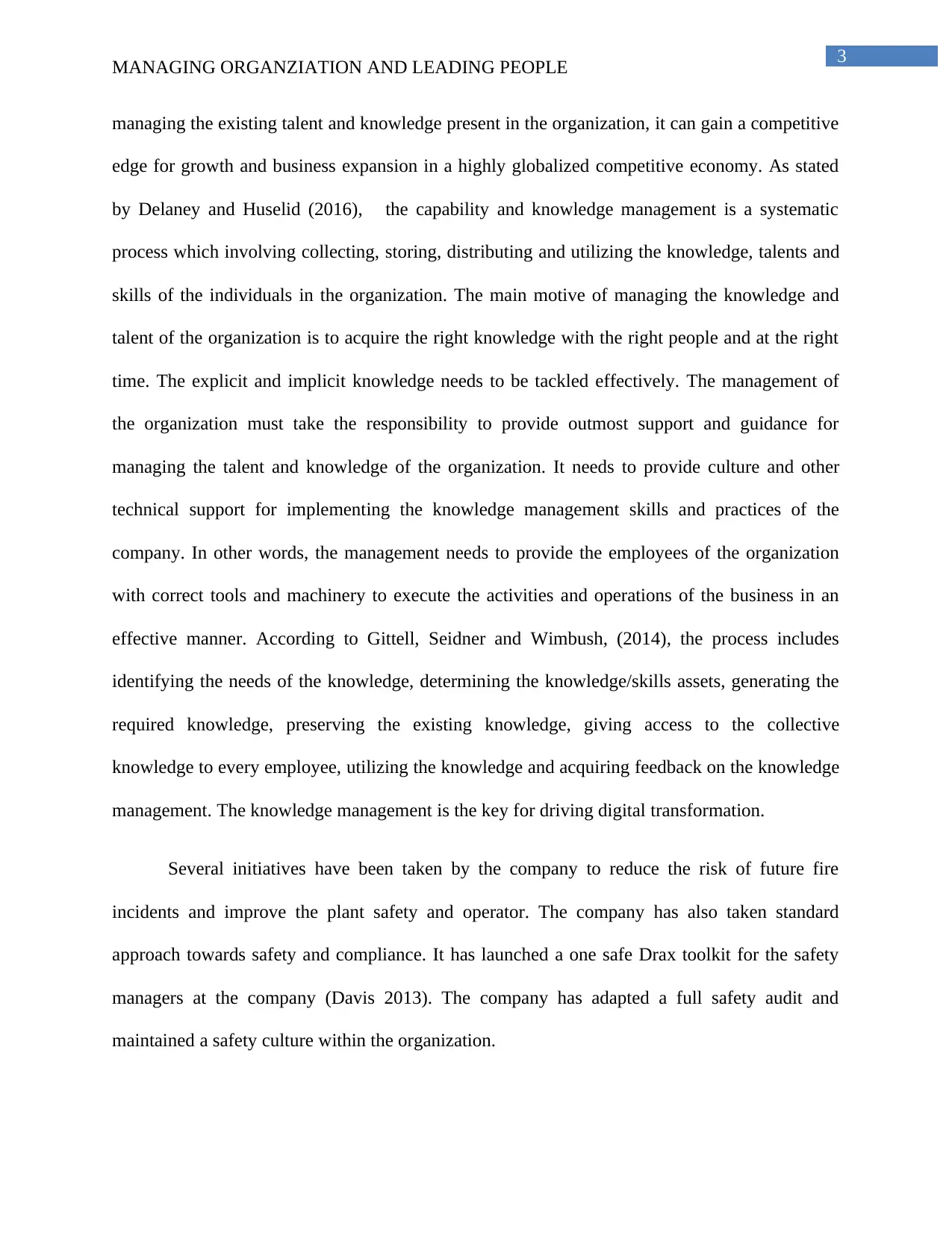
3
MANAGING ORGANZIATION AND LEADING PEOPLE
managing the existing talent and knowledge present in the organization, it can gain a competitive
edge for growth and business expansion in a highly globalized competitive economy. As stated
by Delaney and Huselid (2016), the capability and knowledge management is a systematic
process which involving collecting, storing, distributing and utilizing the knowledge, talents and
skills of the individuals in the organization. The main motive of managing the knowledge and
talent of the organization is to acquire the right knowledge with the right people and at the right
time. The explicit and implicit knowledge needs to be tackled effectively. The management of
the organization must take the responsibility to provide outmost support and guidance for
managing the talent and knowledge of the organization. It needs to provide culture and other
technical support for implementing the knowledge management skills and practices of the
company. In other words, the management needs to provide the employees of the organization
with correct tools and machinery to execute the activities and operations of the business in an
effective manner. According to Gittell, Seidner and Wimbush, (2014), the process includes
identifying the needs of the knowledge, determining the knowledge/skills assets, generating the
required knowledge, preserving the existing knowledge, giving access to the collective
knowledge to every employee, utilizing the knowledge and acquiring feedback on the knowledge
management. The knowledge management is the key for driving digital transformation.
Several initiatives have been taken by the company to reduce the risk of future fire
incidents and improve the plant safety and operator. The company has also taken standard
approach towards safety and compliance. It has launched a one safe Drax toolkit for the safety
managers at the company (Davis 2013). The company has adapted a full safety audit and
maintained a safety culture within the organization.
MANAGING ORGANZIATION AND LEADING PEOPLE
managing the existing talent and knowledge present in the organization, it can gain a competitive
edge for growth and business expansion in a highly globalized competitive economy. As stated
by Delaney and Huselid (2016), the capability and knowledge management is a systematic
process which involving collecting, storing, distributing and utilizing the knowledge, talents and
skills of the individuals in the organization. The main motive of managing the knowledge and
talent of the organization is to acquire the right knowledge with the right people and at the right
time. The explicit and implicit knowledge needs to be tackled effectively. The management of
the organization must take the responsibility to provide outmost support and guidance for
managing the talent and knowledge of the organization. It needs to provide culture and other
technical support for implementing the knowledge management skills and practices of the
company. In other words, the management needs to provide the employees of the organization
with correct tools and machinery to execute the activities and operations of the business in an
effective manner. According to Gittell, Seidner and Wimbush, (2014), the process includes
identifying the needs of the knowledge, determining the knowledge/skills assets, generating the
required knowledge, preserving the existing knowledge, giving access to the collective
knowledge to every employee, utilizing the knowledge and acquiring feedback on the knowledge
management. The knowledge management is the key for driving digital transformation.
Several initiatives have been taken by the company to reduce the risk of future fire
incidents and improve the plant safety and operator. The company has also taken standard
approach towards safety and compliance. It has launched a one safe Drax toolkit for the safety
managers at the company (Davis 2013). The company has adapted a full safety audit and
maintained a safety culture within the organization.
Paraphrase This Document
Need a fresh take? Get an instant paraphrase of this document with our AI Paraphraser
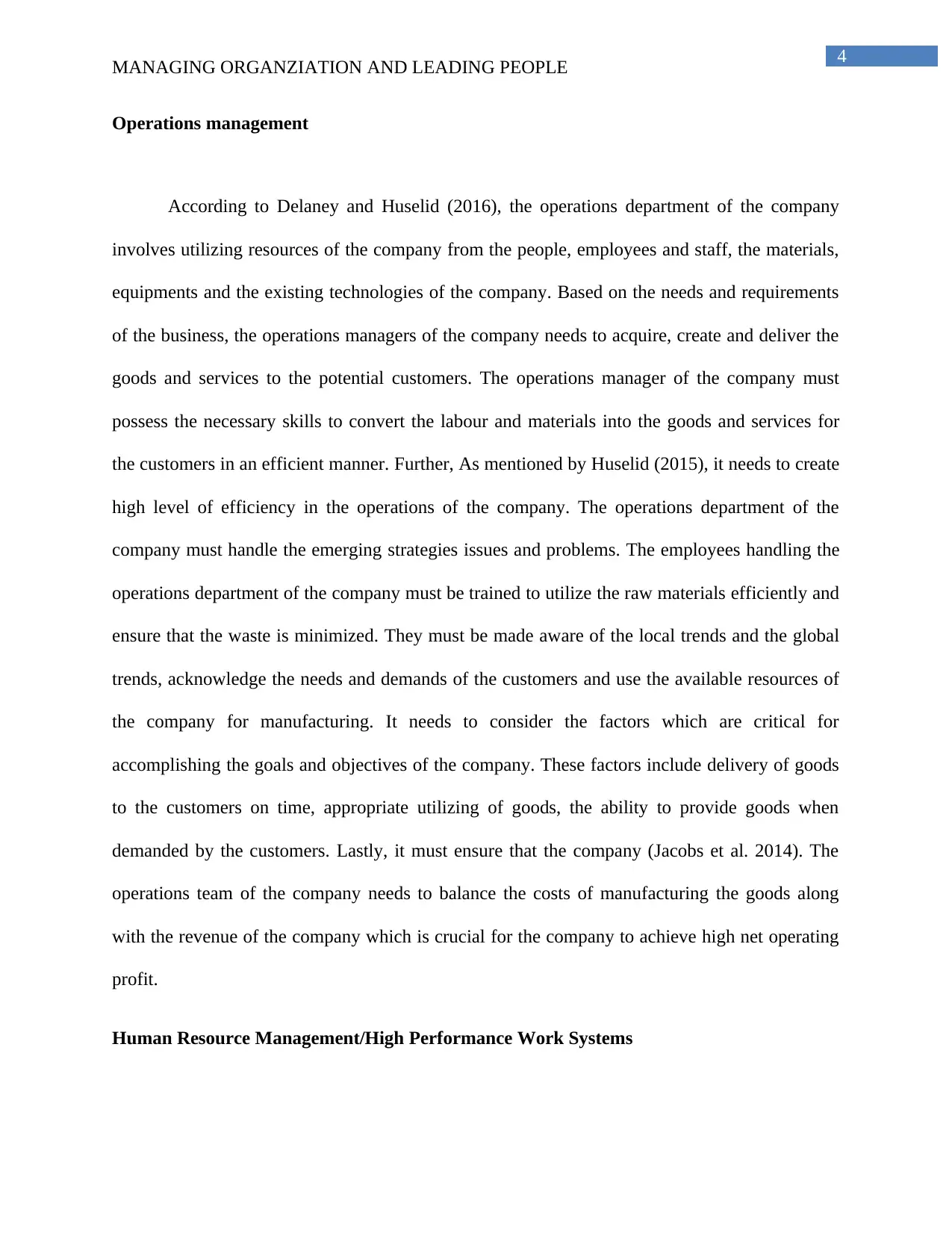
4
MANAGING ORGANZIATION AND LEADING PEOPLE
Operations management
According to Delaney and Huselid (2016), the operations department of the company
involves utilizing resources of the company from the people, employees and staff, the materials,
equipments and the existing technologies of the company. Based on the needs and requirements
of the business, the operations managers of the company needs to acquire, create and deliver the
goods and services to the potential customers. The operations manager of the company must
possess the necessary skills to convert the labour and materials into the goods and services for
the customers in an efficient manner. Further, As mentioned by Huselid (2015), it needs to create
high level of efficiency in the operations of the company. The operations department of the
company must handle the emerging strategies issues and problems. The employees handling the
operations department of the company must be trained to utilize the raw materials efficiently and
ensure that the waste is minimized. They must be made aware of the local trends and the global
trends, acknowledge the needs and demands of the customers and use the available resources of
the company for manufacturing. It needs to consider the factors which are critical for
accomplishing the goals and objectives of the company. These factors include delivery of goods
to the customers on time, appropriate utilizing of goods, the ability to provide goods when
demanded by the customers. Lastly, it must ensure that the company (Jacobs et al. 2014). The
operations team of the company needs to balance the costs of manufacturing the goods along
with the revenue of the company which is crucial for the company to achieve high net operating
profit.
Human Resource Management/High Performance Work Systems
MANAGING ORGANZIATION AND LEADING PEOPLE
Operations management
According to Delaney and Huselid (2016), the operations department of the company
involves utilizing resources of the company from the people, employees and staff, the materials,
equipments and the existing technologies of the company. Based on the needs and requirements
of the business, the operations managers of the company needs to acquire, create and deliver the
goods and services to the potential customers. The operations manager of the company must
possess the necessary skills to convert the labour and materials into the goods and services for
the customers in an efficient manner. Further, As mentioned by Huselid (2015), it needs to create
high level of efficiency in the operations of the company. The operations department of the
company must handle the emerging strategies issues and problems. The employees handling the
operations department of the company must be trained to utilize the raw materials efficiently and
ensure that the waste is minimized. They must be made aware of the local trends and the global
trends, acknowledge the needs and demands of the customers and use the available resources of
the company for manufacturing. It needs to consider the factors which are critical for
accomplishing the goals and objectives of the company. These factors include delivery of goods
to the customers on time, appropriate utilizing of goods, the ability to provide goods when
demanded by the customers. Lastly, it must ensure that the company (Jacobs et al. 2014). The
operations team of the company needs to balance the costs of manufacturing the goods along
with the revenue of the company which is crucial for the company to achieve high net operating
profit.
Human Resource Management/High Performance Work Systems
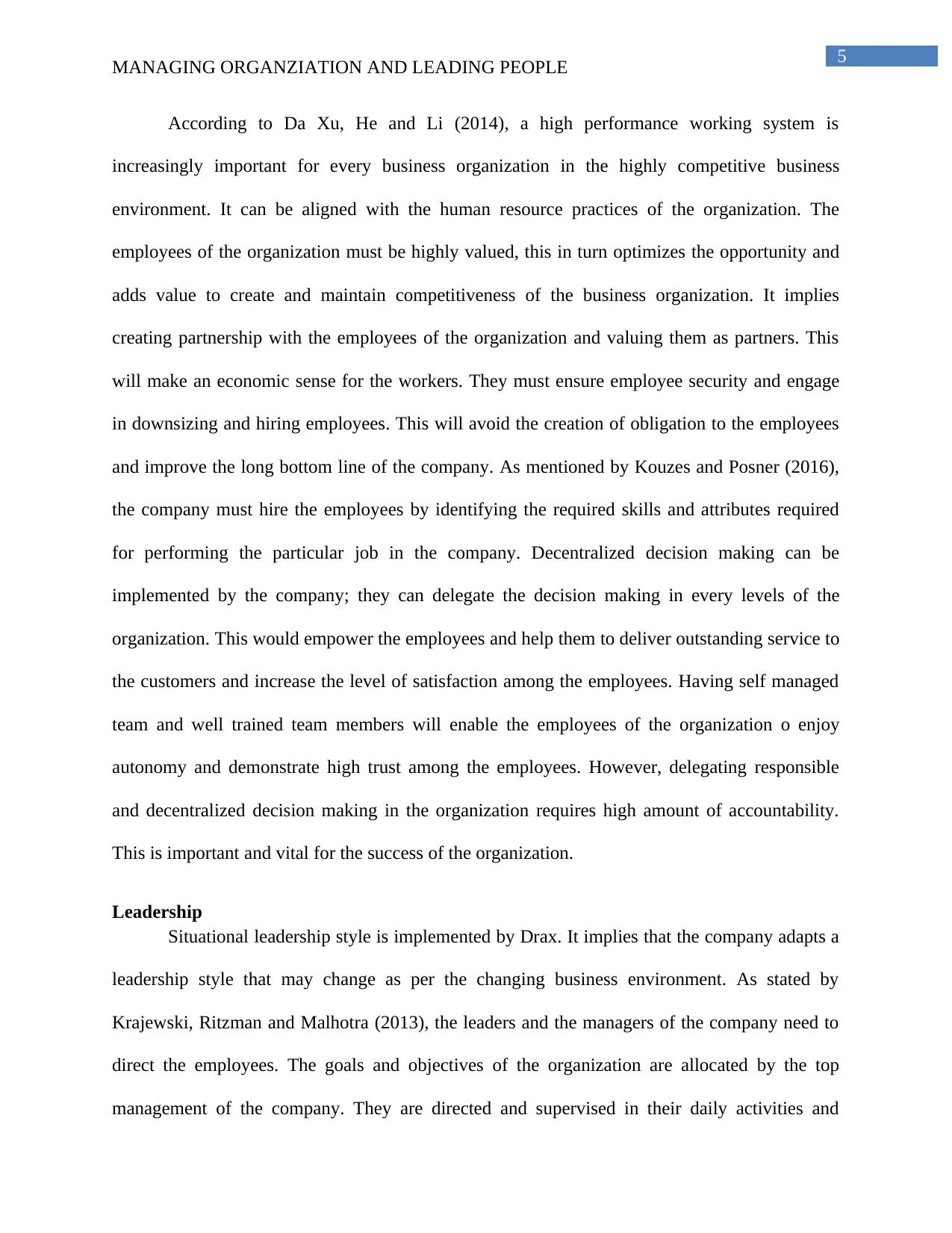
5
MANAGING ORGANZIATION AND LEADING PEOPLE
According to Da Xu, He and Li (2014), a high performance working system is
increasingly important for every business organization in the highly competitive business
environment. It can be aligned with the human resource practices of the organization. The
employees of the organization must be highly valued, this in turn optimizes the opportunity and
adds value to create and maintain competitiveness of the business organization. It implies
creating partnership with the employees of the organization and valuing them as partners. This
will make an economic sense for the workers. They must ensure employee security and engage
in downsizing and hiring employees. This will avoid the creation of obligation to the employees
and improve the long bottom line of the company. As mentioned by Kouzes and Posner (2016),
the company must hire the employees by identifying the required skills and attributes required
for performing the particular job in the company. Decentralized decision making can be
implemented by the company; they can delegate the decision making in every levels of the
organization. This would empower the employees and help them to deliver outstanding service to
the customers and increase the level of satisfaction among the employees. Having self managed
team and well trained team members will enable the employees of the organization o enjoy
autonomy and demonstrate high trust among the employees. However, delegating responsible
and decentralized decision making in the organization requires high amount of accountability.
This is important and vital for the success of the organization.
Leadership
Situational leadership style is implemented by Drax. It implies that the company adapts a
leadership style that may change as per the changing business environment. As stated by
Krajewski, Ritzman and Malhotra (2013), the leaders and the managers of the company need to
direct the employees. The goals and objectives of the organization are allocated by the top
management of the company. They are directed and supervised in their daily activities and
MANAGING ORGANZIATION AND LEADING PEOPLE
According to Da Xu, He and Li (2014), a high performance working system is
increasingly important for every business organization in the highly competitive business
environment. It can be aligned with the human resource practices of the organization. The
employees of the organization must be highly valued, this in turn optimizes the opportunity and
adds value to create and maintain competitiveness of the business organization. It implies
creating partnership with the employees of the organization and valuing them as partners. This
will make an economic sense for the workers. They must ensure employee security and engage
in downsizing and hiring employees. This will avoid the creation of obligation to the employees
and improve the long bottom line of the company. As mentioned by Kouzes and Posner (2016),
the company must hire the employees by identifying the required skills and attributes required
for performing the particular job in the company. Decentralized decision making can be
implemented by the company; they can delegate the decision making in every levels of the
organization. This would empower the employees and help them to deliver outstanding service to
the customers and increase the level of satisfaction among the employees. Having self managed
team and well trained team members will enable the employees of the organization o enjoy
autonomy and demonstrate high trust among the employees. However, delegating responsible
and decentralized decision making in the organization requires high amount of accountability.
This is important and vital for the success of the organization.
Leadership
Situational leadership style is implemented by Drax. It implies that the company adapts a
leadership style that may change as per the changing business environment. As stated by
Krajewski, Ritzman and Malhotra (2013), the leaders and the managers of the company need to
direct the employees. The goals and objectives of the organization are allocated by the top
management of the company. They are directed and supervised in their daily activities and
⊘ This is a preview!⊘
Do you want full access?
Subscribe today to unlock all pages.

Trusted by 1+ million students worldwide
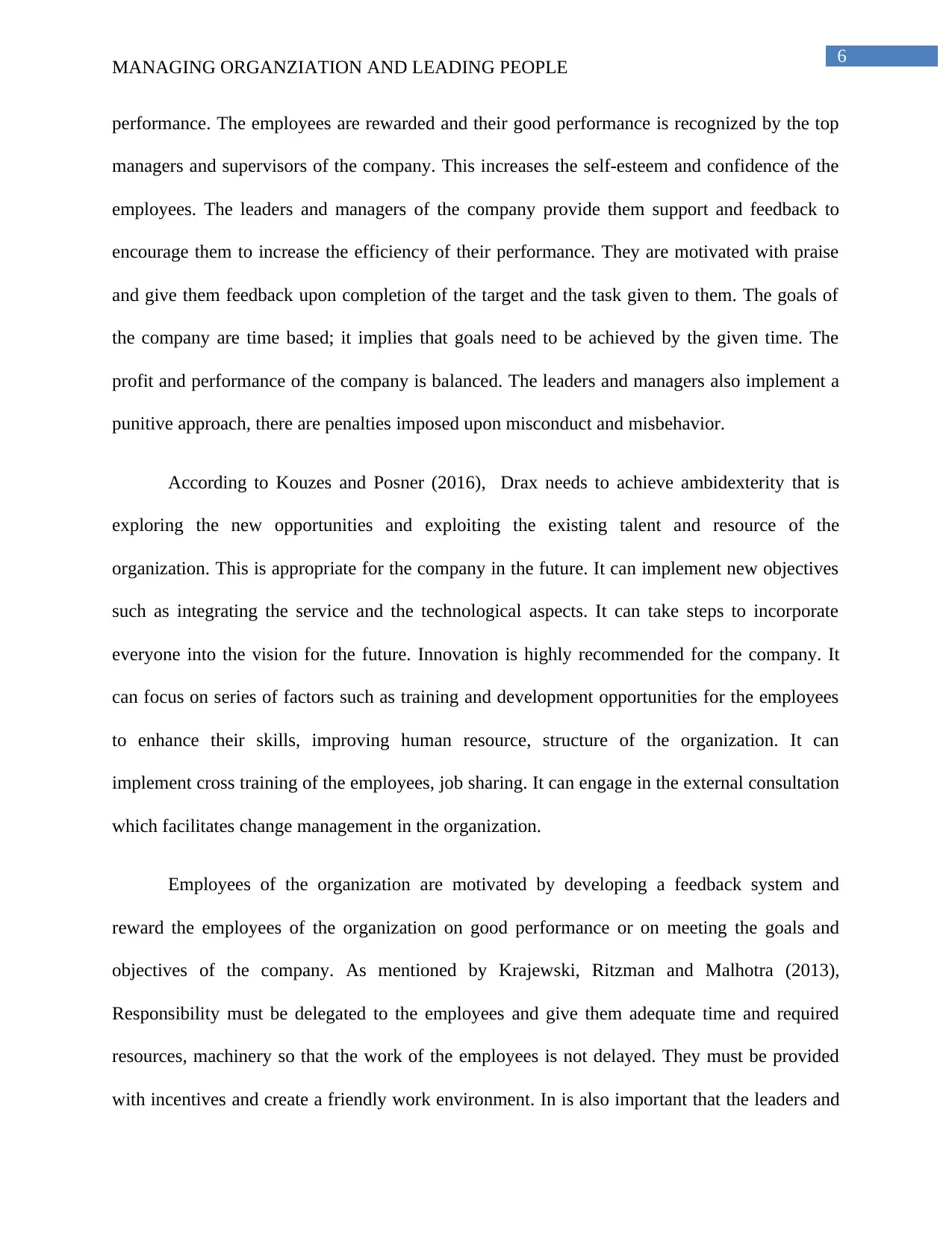
6
MANAGING ORGANZIATION AND LEADING PEOPLE
performance. The employees are rewarded and their good performance is recognized by the top
managers and supervisors of the company. This increases the self-esteem and confidence of the
employees. The leaders and managers of the company provide them support and feedback to
encourage them to increase the efficiency of their performance. They are motivated with praise
and give them feedback upon completion of the target and the task given to them. The goals of
the company are time based; it implies that goals need to be achieved by the given time. The
profit and performance of the company is balanced. The leaders and managers also implement a
punitive approach, there are penalties imposed upon misconduct and misbehavior.
According to Kouzes and Posner (2016), Drax needs to achieve ambidexterity that is
exploring the new opportunities and exploiting the existing talent and resource of the
organization. This is appropriate for the company in the future. It can implement new objectives
such as integrating the service and the technological aspects. It can take steps to incorporate
everyone into the vision for the future. Innovation is highly recommended for the company. It
can focus on series of factors such as training and development opportunities for the employees
to enhance their skills, improving human resource, structure of the organization. It can
implement cross training of the employees, job sharing. It can engage in the external consultation
which facilitates change management in the organization.
Employees of the organization are motivated by developing a feedback system and
reward the employees of the organization on good performance or on meeting the goals and
objectives of the company. As mentioned by Krajewski, Ritzman and Malhotra (2013),
Responsibility must be delegated to the employees and give them adequate time and required
resources, machinery so that the work of the employees is not delayed. They must be provided
with incentives and create a friendly work environment. In is also important that the leaders and
MANAGING ORGANZIATION AND LEADING PEOPLE
performance. The employees are rewarded and their good performance is recognized by the top
managers and supervisors of the company. This increases the self-esteem and confidence of the
employees. The leaders and managers of the company provide them support and feedback to
encourage them to increase the efficiency of their performance. They are motivated with praise
and give them feedback upon completion of the target and the task given to them. The goals of
the company are time based; it implies that goals need to be achieved by the given time. The
profit and performance of the company is balanced. The leaders and managers also implement a
punitive approach, there are penalties imposed upon misconduct and misbehavior.
According to Kouzes and Posner (2016), Drax needs to achieve ambidexterity that is
exploring the new opportunities and exploiting the existing talent and resource of the
organization. This is appropriate for the company in the future. It can implement new objectives
such as integrating the service and the technological aspects. It can take steps to incorporate
everyone into the vision for the future. Innovation is highly recommended for the company. It
can focus on series of factors such as training and development opportunities for the employees
to enhance their skills, improving human resource, structure of the organization. It can
implement cross training of the employees, job sharing. It can engage in the external consultation
which facilitates change management in the organization.
Employees of the organization are motivated by developing a feedback system and
reward the employees of the organization on good performance or on meeting the goals and
objectives of the company. As mentioned by Krajewski, Ritzman and Malhotra (2013),
Responsibility must be delegated to the employees and give them adequate time and required
resources, machinery so that the work of the employees is not delayed. They must be provided
with incentives and create a friendly work environment. In is also important that the leaders and
Paraphrase This Document
Need a fresh take? Get an instant paraphrase of this document with our AI Paraphraser
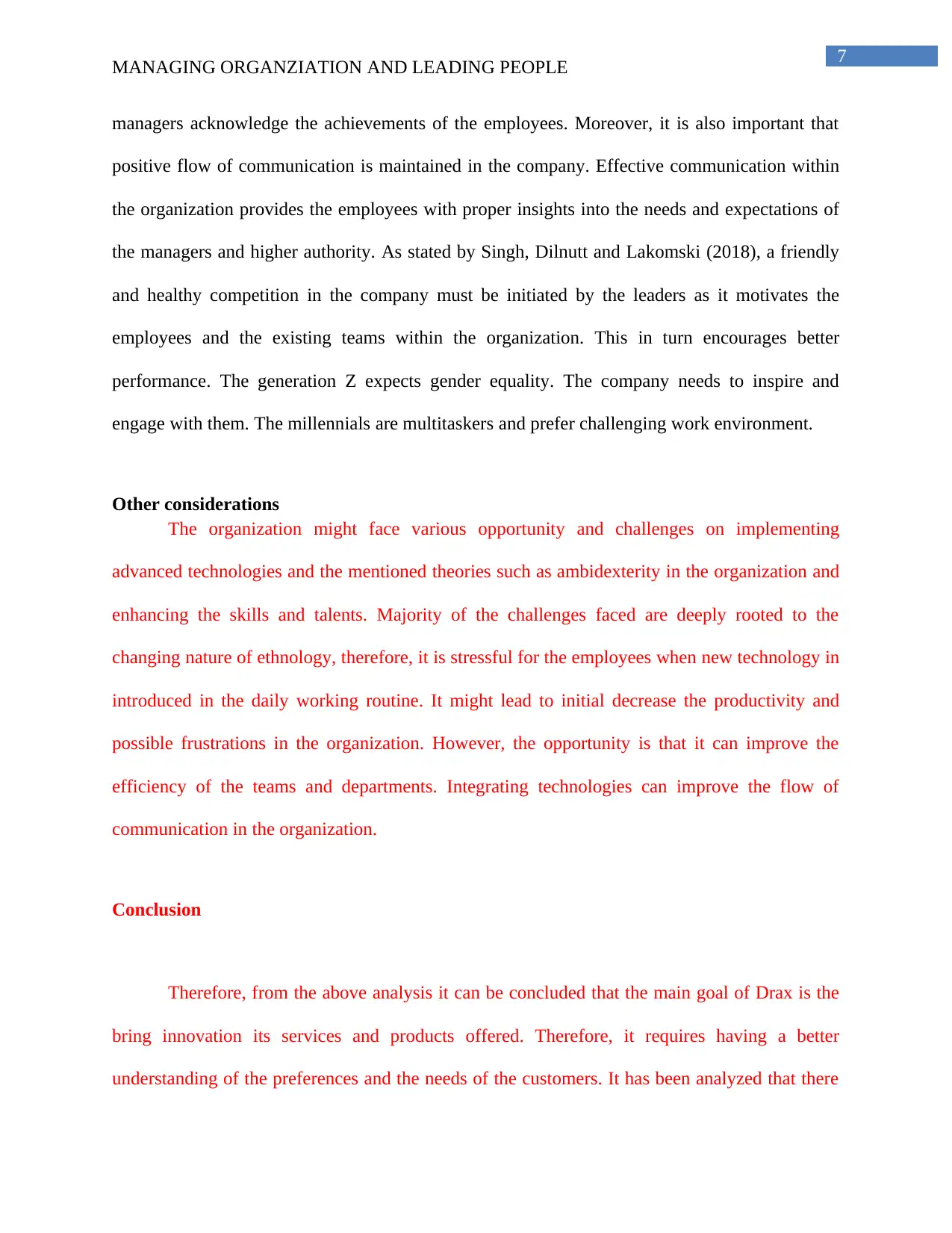
7
MANAGING ORGANZIATION AND LEADING PEOPLE
managers acknowledge the achievements of the employees. Moreover, it is also important that
positive flow of communication is maintained in the company. Effective communication within
the organization provides the employees with proper insights into the needs and expectations of
the managers and higher authority. As stated by Singh, Dilnutt and Lakomski (2018), a friendly
and healthy competition in the company must be initiated by the leaders as it motivates the
employees and the existing teams within the organization. This in turn encourages better
performance. The generation Z expects gender equality. The company needs to inspire and
engage with them. The millennials are multitaskers and prefer challenging work environment.
Other considerations
The organization might face various opportunity and challenges on implementing
advanced technologies and the mentioned theories such as ambidexterity in the organization and
enhancing the skills and talents. Majority of the challenges faced are deeply rooted to the
changing nature of ethnology, therefore, it is stressful for the employees when new technology in
introduced in the daily working routine. It might lead to initial decrease the productivity and
possible frustrations in the organization. However, the opportunity is that it can improve the
efficiency of the teams and departments. Integrating technologies can improve the flow of
communication in the organization.
Conclusion
Therefore, from the above analysis it can be concluded that the main goal of Drax is the
bring innovation its services and products offered. Therefore, it requires having a better
understanding of the preferences and the needs of the customers. It has been analyzed that there
MANAGING ORGANZIATION AND LEADING PEOPLE
managers acknowledge the achievements of the employees. Moreover, it is also important that
positive flow of communication is maintained in the company. Effective communication within
the organization provides the employees with proper insights into the needs and expectations of
the managers and higher authority. As stated by Singh, Dilnutt and Lakomski (2018), a friendly
and healthy competition in the company must be initiated by the leaders as it motivates the
employees and the existing teams within the organization. This in turn encourages better
performance. The generation Z expects gender equality. The company needs to inspire and
engage with them. The millennials are multitaskers and prefer challenging work environment.
Other considerations
The organization might face various opportunity and challenges on implementing
advanced technologies and the mentioned theories such as ambidexterity in the organization and
enhancing the skills and talents. Majority of the challenges faced are deeply rooted to the
changing nature of ethnology, therefore, it is stressful for the employees when new technology in
introduced in the daily working routine. It might lead to initial decrease the productivity and
possible frustrations in the organization. However, the opportunity is that it can improve the
efficiency of the teams and departments. Integrating technologies can improve the flow of
communication in the organization.
Conclusion
Therefore, from the above analysis it can be concluded that the main goal of Drax is the
bring innovation its services and products offered. Therefore, it requires having a better
understanding of the preferences and the needs of the customers. It has been analyzed that there
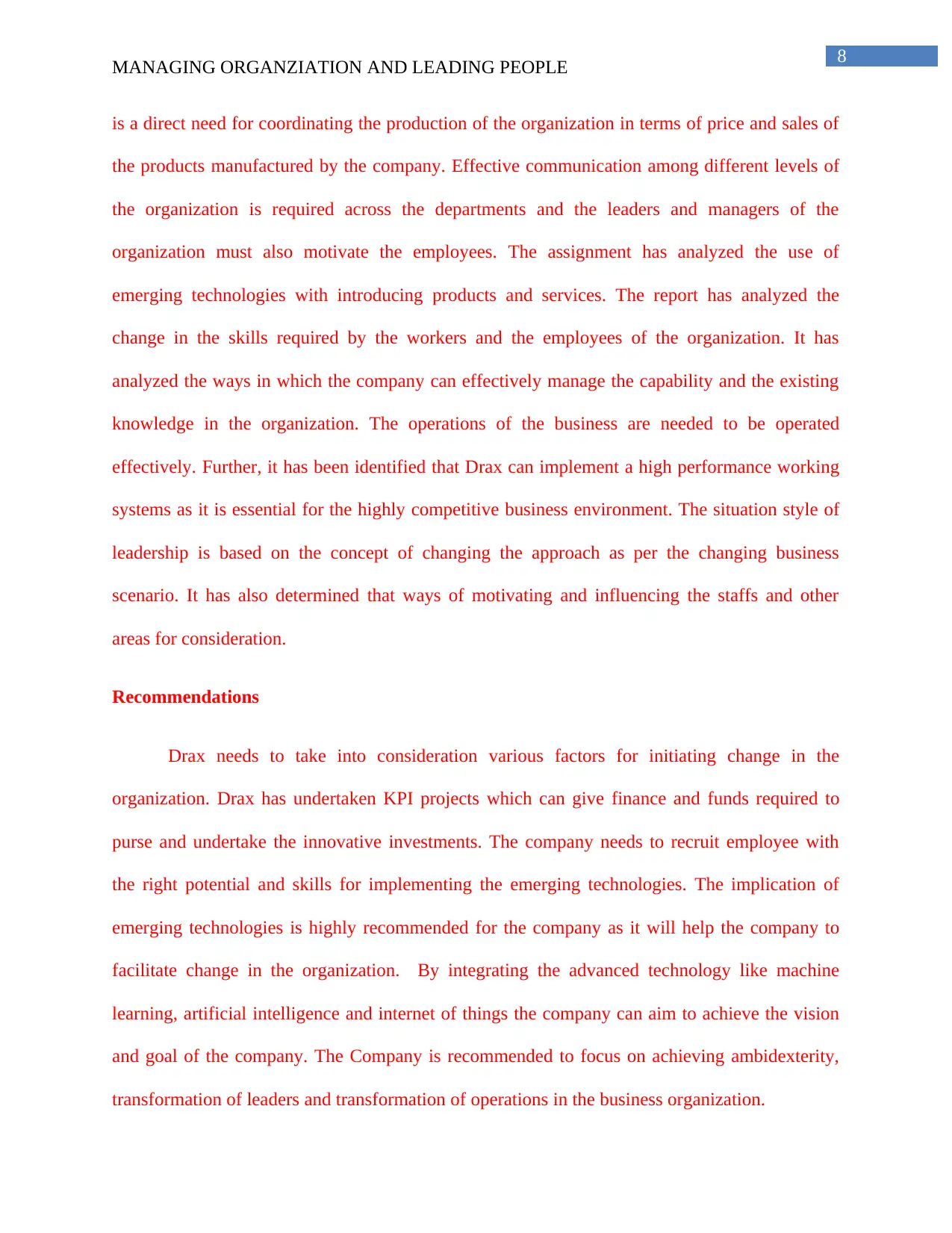
8
MANAGING ORGANZIATION AND LEADING PEOPLE
is a direct need for coordinating the production of the organization in terms of price and sales of
the products manufactured by the company. Effective communication among different levels of
the organization is required across the departments and the leaders and managers of the
organization must also motivate the employees. The assignment has analyzed the use of
emerging technologies with introducing products and services. The report has analyzed the
change in the skills required by the workers and the employees of the organization. It has
analyzed the ways in which the company can effectively manage the capability and the existing
knowledge in the organization. The operations of the business are needed to be operated
effectively. Further, it has been identified that Drax can implement a high performance working
systems as it is essential for the highly competitive business environment. The situation style of
leadership is based on the concept of changing the approach as per the changing business
scenario. It has also determined that ways of motivating and influencing the staffs and other
areas for consideration.
Recommendations
Drax needs to take into consideration various factors for initiating change in the
organization. Drax has undertaken KPI projects which can give finance and funds required to
purse and undertake the innovative investments. The company needs to recruit employee with
the right potential and skills for implementing the emerging technologies. The implication of
emerging technologies is highly recommended for the company as it will help the company to
facilitate change in the organization. By integrating the advanced technology like machine
learning, artificial intelligence and internet of things the company can aim to achieve the vision
and goal of the company. The Company is recommended to focus on achieving ambidexterity,
transformation of leaders and transformation of operations in the business organization.
MANAGING ORGANZIATION AND LEADING PEOPLE
is a direct need for coordinating the production of the organization in terms of price and sales of
the products manufactured by the company. Effective communication among different levels of
the organization is required across the departments and the leaders and managers of the
organization must also motivate the employees. The assignment has analyzed the use of
emerging technologies with introducing products and services. The report has analyzed the
change in the skills required by the workers and the employees of the organization. It has
analyzed the ways in which the company can effectively manage the capability and the existing
knowledge in the organization. The operations of the business are needed to be operated
effectively. Further, it has been identified that Drax can implement a high performance working
systems as it is essential for the highly competitive business environment. The situation style of
leadership is based on the concept of changing the approach as per the changing business
scenario. It has also determined that ways of motivating and influencing the staffs and other
areas for consideration.
Recommendations
Drax needs to take into consideration various factors for initiating change in the
organization. Drax has undertaken KPI projects which can give finance and funds required to
purse and undertake the innovative investments. The company needs to recruit employee with
the right potential and skills for implementing the emerging technologies. The implication of
emerging technologies is highly recommended for the company as it will help the company to
facilitate change in the organization. By integrating the advanced technology like machine
learning, artificial intelligence and internet of things the company can aim to achieve the vision
and goal of the company. The Company is recommended to focus on achieving ambidexterity,
transformation of leaders and transformation of operations in the business organization.
⊘ This is a preview!⊘
Do you want full access?
Subscribe today to unlock all pages.

Trusted by 1+ million students worldwide
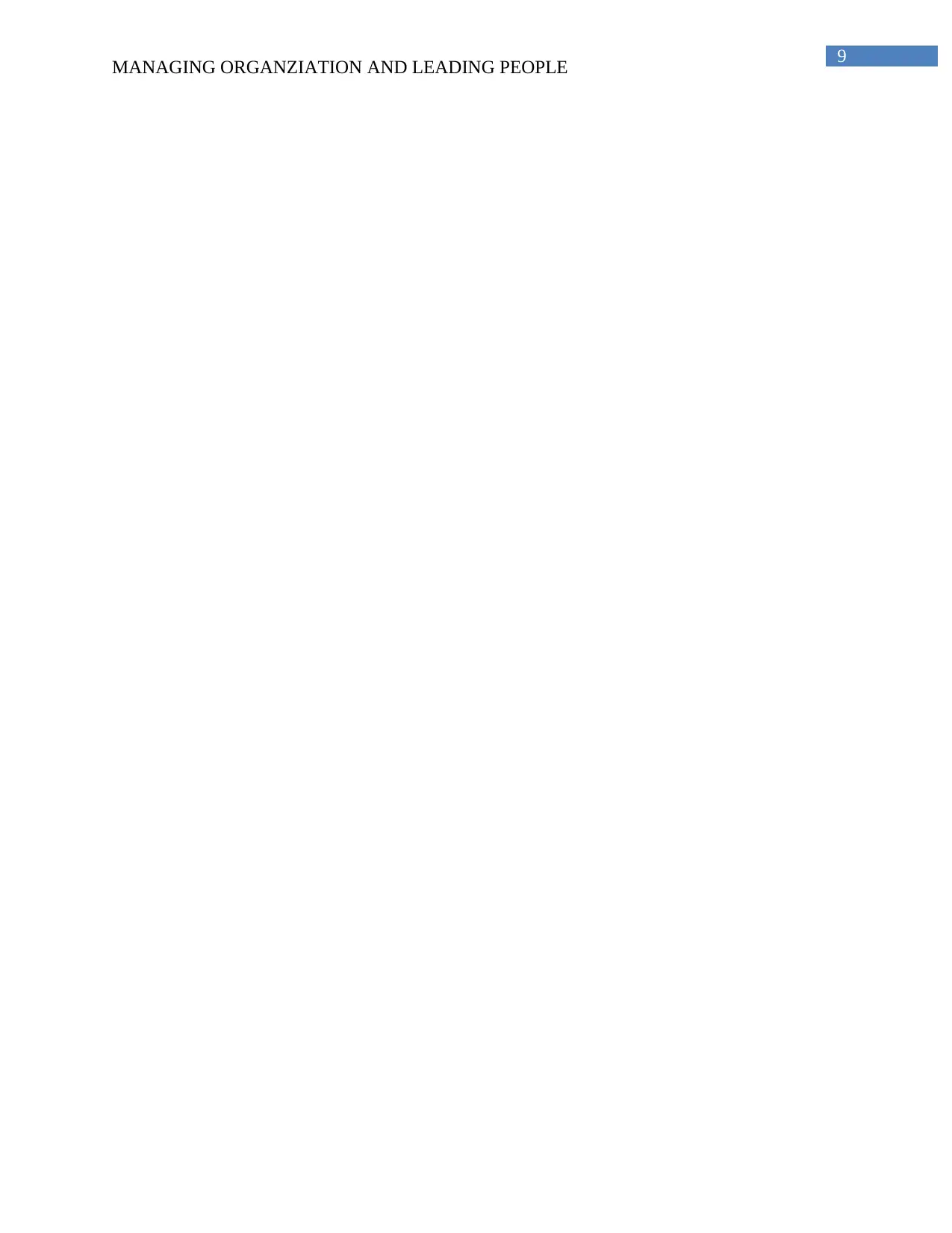
9
MANAGING ORGANZIATION AND LEADING PEOPLE
MANAGING ORGANZIATION AND LEADING PEOPLE
Paraphrase This Document
Need a fresh take? Get an instant paraphrase of this document with our AI Paraphraser
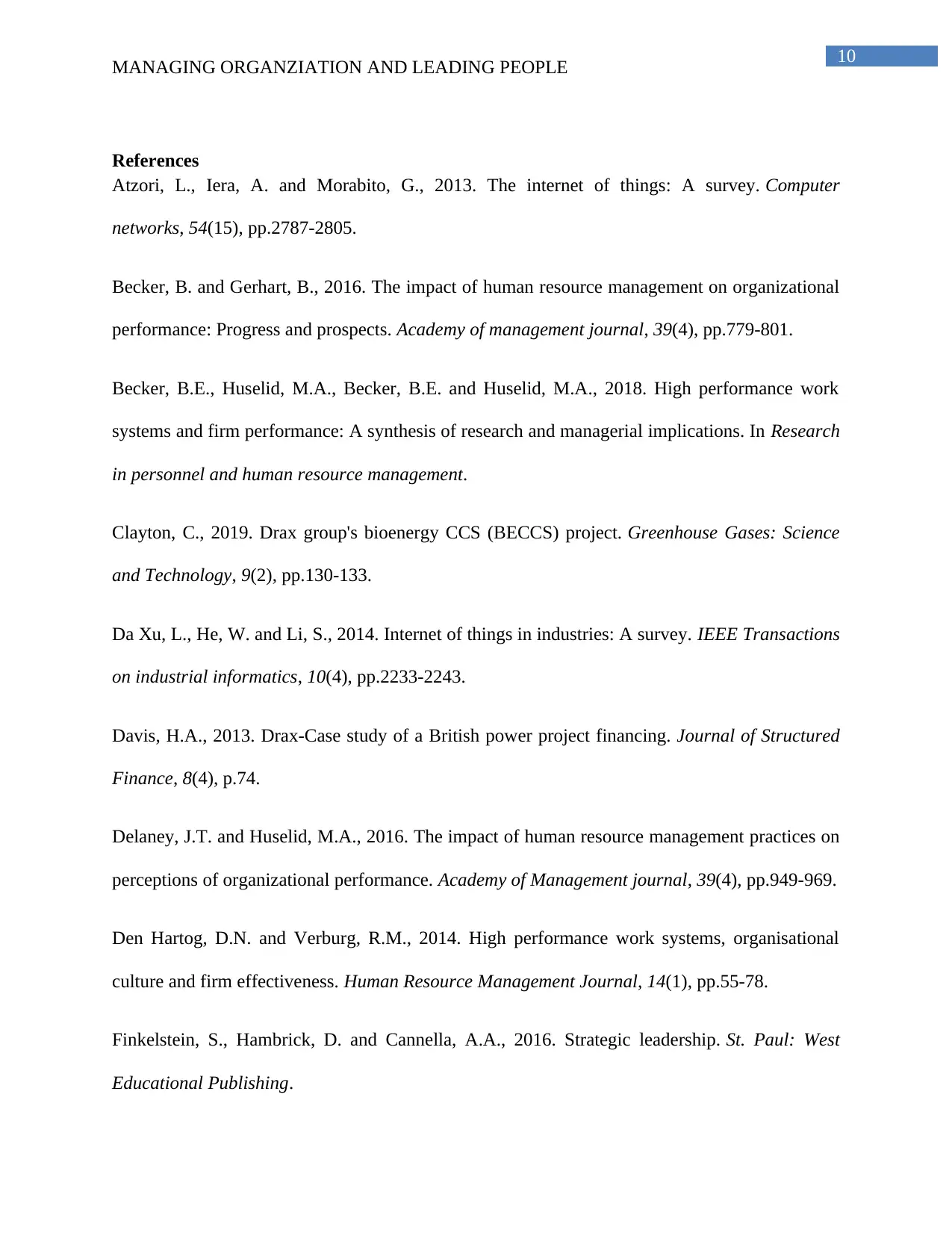
10
MANAGING ORGANZIATION AND LEADING PEOPLE
References
Atzori, L., Iera, A. and Morabito, G., 2013. The internet of things: A survey. Computer
networks, 54(15), pp.2787-2805.
Becker, B. and Gerhart, B., 2016. The impact of human resource management on organizational
performance: Progress and prospects. Academy of management journal, 39(4), pp.779-801.
Becker, B.E., Huselid, M.A., Becker, B.E. and Huselid, M.A., 2018. High performance work
systems and firm performance: A synthesis of research and managerial implications. In Research
in personnel and human resource management.
Clayton, C., 2019. Drax group's bioenergy CCS (BECCS) project. Greenhouse Gases: Science
and Technology, 9(2), pp.130-133.
Da Xu, L., He, W. and Li, S., 2014. Internet of things in industries: A survey. IEEE Transactions
on industrial informatics, 10(4), pp.2233-2243.
Davis, H.A., 2013. Drax-Case study of a British power project financing. Journal of Structured
Finance, 8(4), p.74.
Delaney, J.T. and Huselid, M.A., 2016. The impact of human resource management practices on
perceptions of organizational performance. Academy of Management journal, 39(4), pp.949-969.
Den Hartog, D.N. and Verburg, R.M., 2014. High performance work systems, organisational
culture and firm effectiveness. Human Resource Management Journal, 14(1), pp.55-78.
Finkelstein, S., Hambrick, D. and Cannella, A.A., 2016. Strategic leadership. St. Paul: West
Educational Publishing.
MANAGING ORGANZIATION AND LEADING PEOPLE
References
Atzori, L., Iera, A. and Morabito, G., 2013. The internet of things: A survey. Computer
networks, 54(15), pp.2787-2805.
Becker, B. and Gerhart, B., 2016. The impact of human resource management on organizational
performance: Progress and prospects. Academy of management journal, 39(4), pp.779-801.
Becker, B.E., Huselid, M.A., Becker, B.E. and Huselid, M.A., 2018. High performance work
systems and firm performance: A synthesis of research and managerial implications. In Research
in personnel and human resource management.
Clayton, C., 2019. Drax group's bioenergy CCS (BECCS) project. Greenhouse Gases: Science
and Technology, 9(2), pp.130-133.
Da Xu, L., He, W. and Li, S., 2014. Internet of things in industries: A survey. IEEE Transactions
on industrial informatics, 10(4), pp.2233-2243.
Davis, H.A., 2013. Drax-Case study of a British power project financing. Journal of Structured
Finance, 8(4), p.74.
Delaney, J.T. and Huselid, M.A., 2016. The impact of human resource management practices on
perceptions of organizational performance. Academy of Management journal, 39(4), pp.949-969.
Den Hartog, D.N. and Verburg, R.M., 2014. High performance work systems, organisational
culture and firm effectiveness. Human Resource Management Journal, 14(1), pp.55-78.
Finkelstein, S., Hambrick, D. and Cannella, A.A., 2016. Strategic leadership. St. Paul: West
Educational Publishing.
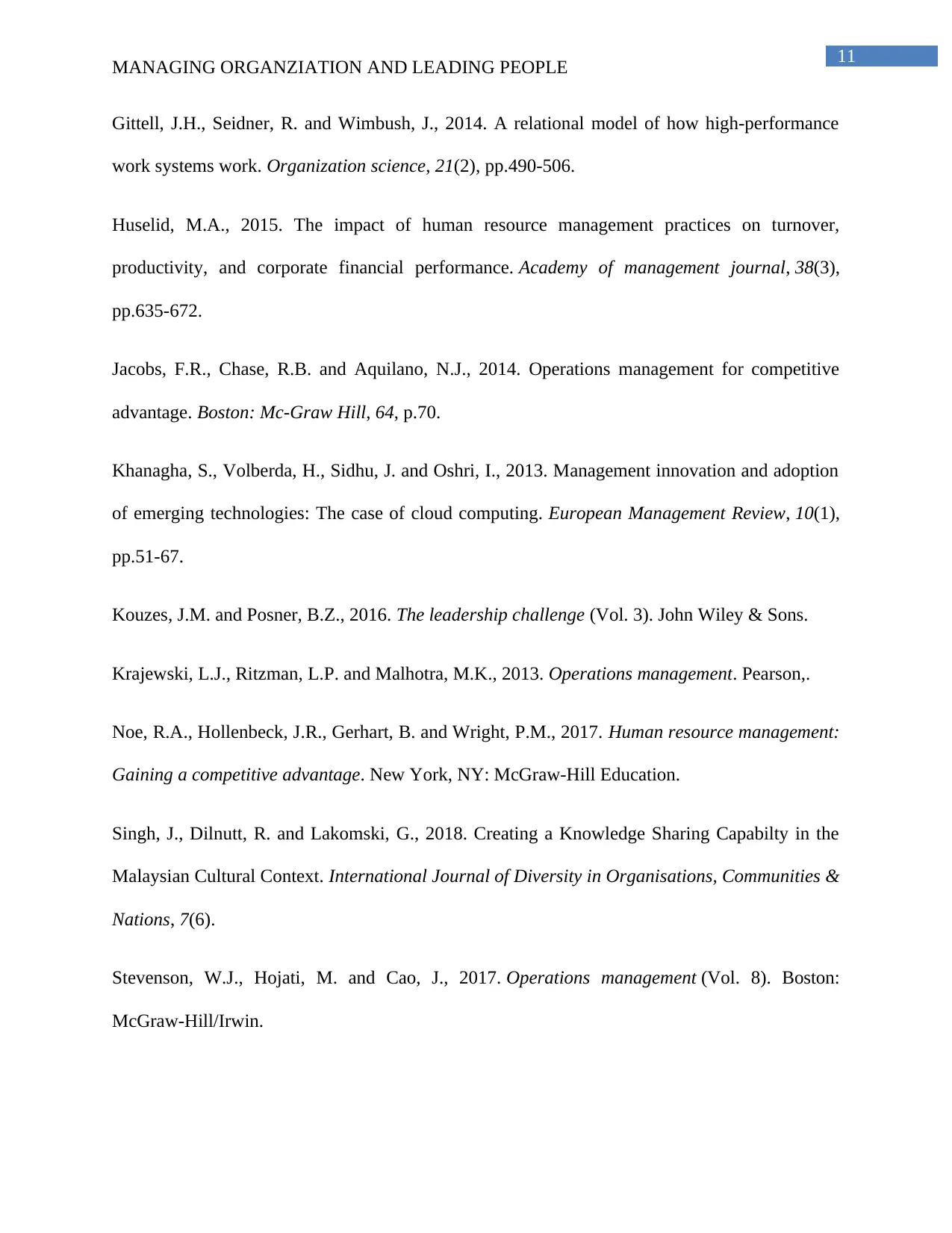
11
MANAGING ORGANZIATION AND LEADING PEOPLE
Gittell, J.H., Seidner, R. and Wimbush, J., 2014. A relational model of how high-performance
work systems work. Organization science, 21(2), pp.490-506.
Huselid, M.A., 2015. The impact of human resource management practices on turnover,
productivity, and corporate financial performance. Academy of management journal, 38(3),
pp.635-672.
Jacobs, F.R., Chase, R.B. and Aquilano, N.J., 2014. Operations management for competitive
advantage. Boston: Mc-Graw Hill, 64, p.70.
Khanagha, S., Volberda, H., Sidhu, J. and Oshri, I., 2013. Management innovation and adoption
of emerging technologies: The case of cloud computing. European Management Review, 10(1),
pp.51-67.
Kouzes, J.M. and Posner, B.Z., 2016. The leadership challenge (Vol. 3). John Wiley & Sons.
Krajewski, L.J., Ritzman, L.P. and Malhotra, M.K., 2013. Operations management. Pearson,.
Noe, R.A., Hollenbeck, J.R., Gerhart, B. and Wright, P.M., 2017. Human resource management:
Gaining a competitive advantage. New York, NY: McGraw-Hill Education.
Singh, J., Dilnutt, R. and Lakomski, G., 2018. Creating a Knowledge Sharing Capabilty in the
Malaysian Cultural Context. International Journal of Diversity in Organisations, Communities &
Nations, 7(6).
Stevenson, W.J., Hojati, M. and Cao, J., 2017. Operations management (Vol. 8). Boston:
McGraw-Hill/Irwin.
MANAGING ORGANZIATION AND LEADING PEOPLE
Gittell, J.H., Seidner, R. and Wimbush, J., 2014. A relational model of how high-performance
work systems work. Organization science, 21(2), pp.490-506.
Huselid, M.A., 2015. The impact of human resource management practices on turnover,
productivity, and corporate financial performance. Academy of management journal, 38(3),
pp.635-672.
Jacobs, F.R., Chase, R.B. and Aquilano, N.J., 2014. Operations management for competitive
advantage. Boston: Mc-Graw Hill, 64, p.70.
Khanagha, S., Volberda, H., Sidhu, J. and Oshri, I., 2013. Management innovation and adoption
of emerging technologies: The case of cloud computing. European Management Review, 10(1),
pp.51-67.
Kouzes, J.M. and Posner, B.Z., 2016. The leadership challenge (Vol. 3). John Wiley & Sons.
Krajewski, L.J., Ritzman, L.P. and Malhotra, M.K., 2013. Operations management. Pearson,.
Noe, R.A., Hollenbeck, J.R., Gerhart, B. and Wright, P.M., 2017. Human resource management:
Gaining a competitive advantage. New York, NY: McGraw-Hill Education.
Singh, J., Dilnutt, R. and Lakomski, G., 2018. Creating a Knowledge Sharing Capabilty in the
Malaysian Cultural Context. International Journal of Diversity in Organisations, Communities &
Nations, 7(6).
Stevenson, W.J., Hojati, M. and Cao, J., 2017. Operations management (Vol. 8). Boston:
McGraw-Hill/Irwin.
⊘ This is a preview!⊘
Do you want full access?
Subscribe today to unlock all pages.

Trusted by 1+ million students worldwide
1 out of 13
Related Documents
Your All-in-One AI-Powered Toolkit for Academic Success.
+13062052269
info@desklib.com
Available 24*7 on WhatsApp / Email
![[object Object]](/_next/static/media/star-bottom.7253800d.svg)
Unlock your academic potential
Copyright © 2020–2025 A2Z Services. All Rights Reserved. Developed and managed by ZUCOL.





